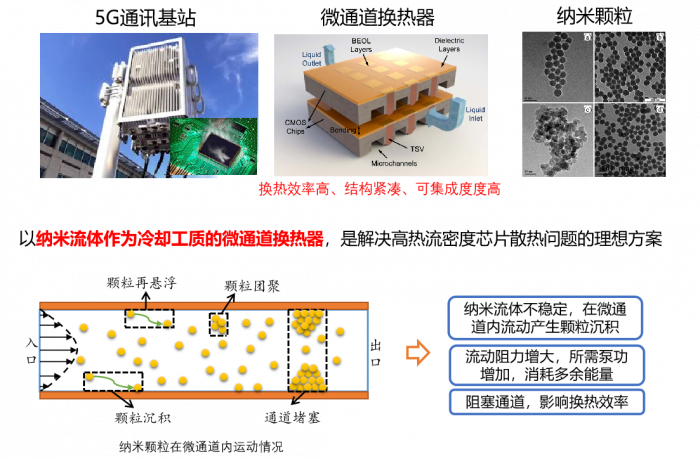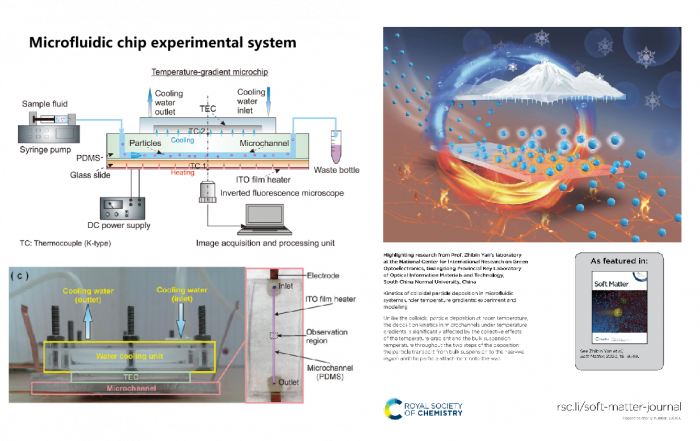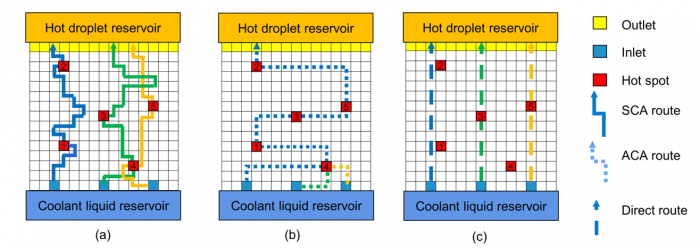Electronics cooling:Heat management system for 5G communication base station
In this paper, we investigate the effect of temperature gradient on the particle deposition of a pressure-driven suspension flow in a microchannel. We designed a microfluidic device which can allow direct observation of the real-time process of particle deposition with single-particle resolution along the direction of applied temperature gradient.
The experimental results show that particle deposition rate is decreased by increasing the applied temperature gradients. Based on the framework of the Derjaguin–Landau–Verwey–Overbeek (DLVO) theory, we then derive a mass transport model to describe the particle deposition under different temperature gradients. The model shows that the observed reduction of particle deposition rate with temperature gradient is due to the collective effect of the temperature gradient and the bulk solution temperature in the two steps of the particle deposition process, including the particle transport and the particle attachment.


Bioinspired Droplet Routing Method for Digital Microfluidic Cooling of Hotspots in Integrated Circuits
Integrated cooling methods based on digital microfluidics (DMF) has been regarded as a promising solution to the effective thermal management of high-performance integrated circuits. This method can realize adaptive cooling by programming a droplet to a target (e.g., hot spot) along a designed path. The droplet route is crucial for the cooling performance, especially, when multiple droplets move on the chip simultaneously and the hot spot distribution is dynamically changed. However, there is hardly research investigating into the droplet routing method for hotspot cooling.
Here, we propose a droplet route optimization method, self-generated chemotaxis-inspired algorithm (SCA), based on the real-time temperature distribution of chip which aims to achieve real-time routing for multiple droplets to search and cool hot spots. The main ideal of the proposed method is to guide a droplet to move in the direction of temperature gradient which is modeled similarly to the migration behavior of chemotactic cells.
Fig. 1 Schematic of chemotaxis and the digital microfluidic (DMF) platform for chip cooling. (a) Schematic of chemotaxis where cells are attracted into nutrient with higher concentration.
Fig. 2a-c show the distribution of five 120 W/cm2 heat sources (i.e., the red cells) and droplets were allowed to be injected from three different inlets using three kinds of routes. To compare the cooling performances of SCA route, Ant colony algorithm (ACA) route and direct route, we simulated 500 droplets cooling the chip based on these three types of routing methods. Fig. 2a illustrates three representative SCA routes. Although each coolant droplet for the SCA method was not predefined to pass all the hot spots, the droplets from three inlets could successfully cover all the hot spots. Different from SCA routes, the basic idea of ACA routes is to program the shortest path that starts from inlet, passes through all the hot spots, and leaves for the outlet. Thus, if the distribution of the hot spots keeps static, an ACA route from a certain inlet will remain unchanged under normal circumstance. As shown in Fig. 2b, there were three ACA routes from three inlets respectively. These three routes had an intersection at the Hot Spot 4 (i.e., the first hot spot visited) and became the same route after confluence. Thus, the target conflicts occurred and restricted the flow flux of the droplets in the ACA case. Compared with ACA routes, SCA routes are planned in real time based on the real-time local temperature distribution rather than predefined only according to the hot spots’ positions. Thus, the SCA routes have a characteristic of diversity and each SCA route is different from each other under normal conditions although the positions of hot spots are fixed. Moreover, the target conflicts in the ACA routes are much more serious than the SCA routes because the former is bound to pass all the hot spots. Fig. 2c shows the direct routes which started from the inlets and went straight to the outlets. When multiple droplets were transported on the chip with direct routes, there would never occur any target conflict.
Fig. 2 Five hundred droplets cooling five 120 W/cm2 hot spots in three-inlet configuration at a speed of 0.1 m/s based on three different kinds of routing methods. (a) Three representative droplet routes based on SCA and they successfully searched all the hot spots. (b) Three ACA routes respectively from three inlets. ACA routes are the shortest paths that start from a certain inlet, pass through all the hot spots, and leave for the outlet. (c) Three direct routes which start from inlets and go straight to the outlets.
Article:
- Zhibin Yan*, Xiaoyang Huang, Lingling Shui and Chun Yang, Kinetics of colloidal particle deposition in microfluidic systems under temperature gradients: experiment and modelling, Soft Matter, 16, 3649-3656, 2020. Backcover封面文章
- Zhibin Yan*, Mingliang Jin, Zhengguang Li, Guofu Zhou and Lingling Shui*, Droplet-Based Microfluidic Thermal Management Methods for High Performance Electronic Devices, Micromachines, 10, 89, 2019. doi:10.3390/mi10020089.
Patent:
- “一种芯片热点冷却装置及其使用方法(202011607765)” 颜智斌 、杨森 、李政光 、廖明 、金名亮 、周国富 、水玲玲
- “数字微流控芯片的液滴路径规划方法及装置(202110552794)”颜智斌 、陈茂华 、陈森隆 、廖明 、金名亮 、周国富 、水玲玲


